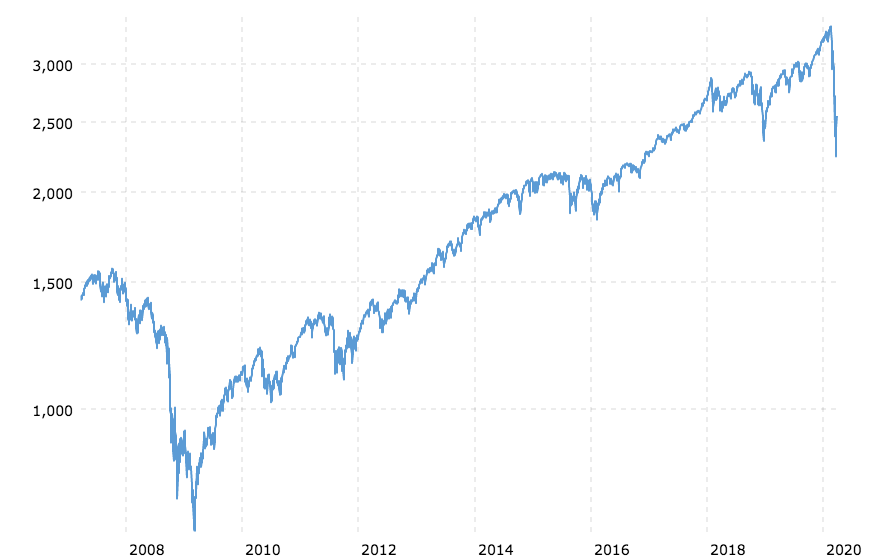March 19, 2020
MARKET UPDATE: COVID-19 PANDEMIC (CORONAVIRUS)
STEPHANIE N. CAMPOS, CFP®
CERTIFIED FINANCIAL PLANNER™
Chances are you’ve heard about the stock market’s negative reaction to COVID-19 (also known as the novel coronavirus). Right now the market is down sharply because investors do not like uncertainty. Trading on headlines created large losses ending an 11-year bull market and even halted trading four times (which hasn’t happened since the 2008 financial crisis). It’s stressful and you may be wondering, how is this going to impact my 401K and retirement accounts? Let’s take a look at the facts and discuss how we should handle these types of fluctuations in the market going forward.
Pandemic
The first case of this virus was detected on Nov. 17th, 2019 but it was more than a month later that the virus seriously impacted Wuhan, China (South Morning China Post).1 By March 11th, the World Health Organization declared the novel coronavirus a global pandemic, meaning it was present on every continent.2 This has happened twice before in recent history, once in 1957 and again in 1968, each with casualties of one million or more worldwide.3 That’s why this virus is serious and many countries have enforced travel restrictions and quarantine measures.
Corporations Affected
Here in the US, many companies and schools have closed in order to create social distancing at the request of the Center For Disease Control (CDC). Although I agree that it’s necessary to slow the spread of the virus, these measures are having unintended financial consequences. We are most likely heading into a recession4, which is defined as a fall in a country’s Gross Domestic Production (GDP) for two quarters in a row. A large number of employees are expected to be laid off or loose their jobs due to low demand within their industries such as airlines, hotels, restaurants and international shipping, among others. We’ve already seen Marriott International, the world’s largest hotel, plan to furlough tens of thousands of workers. Compass Coffee, one of Starbucks competitors in the Washington DC area, laid off 80% of its staff.5 Tough decisions like these are being made across the country, with the smallest companies being hit the hardest. More than 2/3 of the US economy depends on consumer spending. We won’t know for sure the extent the coronavirus is having on the economy until we receive the US economic data in late April (which will include March of 2020) but until then, the market will continue to trade on headlines and assumptions.
China’s Downturn
To gauge how much of an economic disruption to expect, we look at the effect the coronavirus has had on China’s economy so far. Economic data for January and February showed Chinese retail sales were down -20.5% and industrial production was down -13.5%.6 These numbers include 3 weeks of pre-virus production in January, so they aren’t accurate and will most likely be revised lower. The Chinese government is trying to increase their industrial output but it may not be enough to avoid a recession.
The Fed’s Response
The good news is that, here in the US, our banking system is strong and Federal Reserve (The Fed) is taking the situation seriously. The Fed has lowered rates to 0% in an emergency meeting on Sunday, March 15th and is providing $700 billion in liquidity (also known as quantitative easing or QE). The Fed is also guaranteeing the commercial loans that US banks are making to keep companies running and prevent further job loss. In June’s stress test of the US banks, they had enough excess cash reserves to handle a 50% drop in the stock market and 10% unemployment (among other negative factors).7 The Fed’s response has been to reinforce an already strong banking system and ensure that this global health crisis doesn’t turn into a national financial crisis.
The government is also doing its part to limit the financial hardship for the members of our workforce that have no paid time off and little to no emergency savings. The Federal Reserve determined in their most recent Report on the Economic Well-Being of US Households that 40% of Americans, if faced with an unexpected expense of $400 or more, would not be able to cover it.8 With this in mind, a coronavirus relief package was signed into law on Wednesday, March 18th which provides for free testing, paid sick leave for up to two weeks for employees of small companies (500 employees or less) as well as up to 3 months of paid family and medical leave.9 Another bill is in the works to assist small businesses providing $300 billion in loans that would be forgiven if they were used to cover payroll expenses. The debate over how to create a steady income for workers who are being asked to stay home is ongoing. One proposal are stimulus checks of $1,200 per person (with income limitations of $75,000)10 and another is using the already in place unemployment insurance system run by each state.
So now that we know how the Fed, government and industries are coping with the situation, let’s see what we can do as investors. At the moment, a large number of traders are putting their money in cash as seen by the sharp increase in money market mutual funds over the past week. This panicked selling is bringing down the price of almost every company, even the good companies with strong growth and low debt.
Importance of Planning
For more than a decade, investors have been lulled into a false sense of safety and confidence in the stock market due to the impressive +378% gain in the S&P 500 Index (see below). This has lead investors to take on more risk and buy more stocks in their portfolio than they would have if they were working with a financial advisor who is a CERTIFIED FINANCIAL PLANNER™. The financial planning process begins with analyzing a client’s current emergency savings before beginning to invest. This critical step makes sure that clients have enough cash available to cover any unexpected disruptions for several months or years (if you’re already in retirement).
S&P 500 10-Year Chart

(https://www.macrotrends.net/2324/sp-500-historical-chart-data’>S&P 500 Index – 90 Year Historical Chart)
I urge my clients to focus on their specific situation and not the general panic we see in the news. With a carefully thought out financial plan in place and accounts that have been invested to reflect your goals, these turbulent times are easier to endure.
Seeing unrealized losses on your statement is unavoidable but selling now and waiting out the storm in cash will make those unrealized losses a reality and leave you with no opportunity to rebound when the market recovers. Instead, it’s better to sell the investments that are performing poorly and immediately reinvest the proceeds in other parts of the market where you were lacking exposure (this is considered rebalancing).
If you find that you need more cash to cover your non-discretionary household expenses, ask your financial advisor to calculate exactly how much you need and which investments to sell in order to minimize your losses. For younger individuals (more than 10 years from retirement), if you weren’t already, this is a good time to dollar-cost-average (put the same amount on a fixed schedule) into to your 401K or individual retirement accounts (IRA) and buy broadly diversified exchange-traded funds that were much more expensive just a month ago.
The old adage holds true: what goes up, must come down – and in the case of the stock market – back up again. The best thing we can do is to follow our financial plan while we support our families and neighbors through this challenging time.
Certified Financial Planner Board of Standards, Inc. (CFP Board) owns the CFP® certification mark, the CERTIFIED FINANCIAL PLANNER™ certification mark, and the CFP® certification mark (with plaque design) logo in the United States, which it authorizes use of by individuals who successfully complete CFP Board’s initial and ongoing certification requirements.
1 https://www.scmp.com/news/china/society/article/3074991/coronavirus-chinas-first-confirmed-covid-19-case-traced-back
2 https://www.cnn.com/2020/03/11/health/coronavirus-pandemic-world-health-organization/index.html
3 https://www.cdc.gov/flu/pandemic-resources/
4 https://www.bloomberg.com/graphics/us-economic-recession-tracker/
5 https://www.forbes.com/sites/lisettevoytko/2020/03/19/coronavirus-layoffs-met-opera-iatse-latest-to-shed-jobs-during-pandemic/#76e32f001aa5
6 https://www.marketwatch.com/story/chinas-industrial-output-retail-sales-plummet-2020-03-15
7 https://www.federalreserve.gov/publications/files/2019-dfast-results-20190621.pdf
8 https://www.federalreserve.gov/publications/files/2017-report-economic-well-being-us-households-201805.pdf
9 https://www.cnn.com/2020/03/13/politics/coronavirus-relief-congress/index.html
10 https://www.marketwatch.com/story/mcconnells-1-trillion-coronavirus-relief-plan-calls-for-payments-of-1200-per-person-2020-03-19

